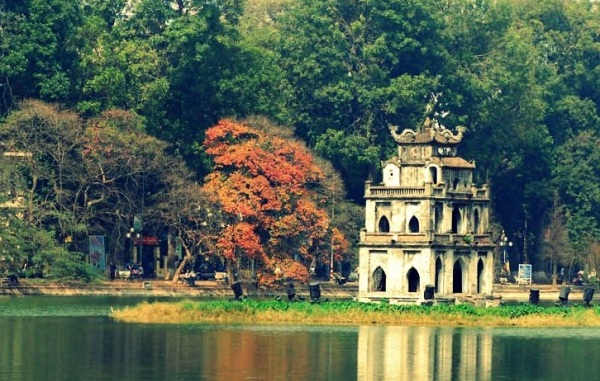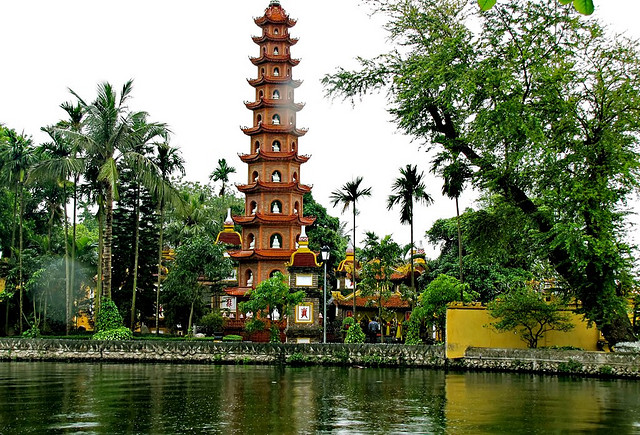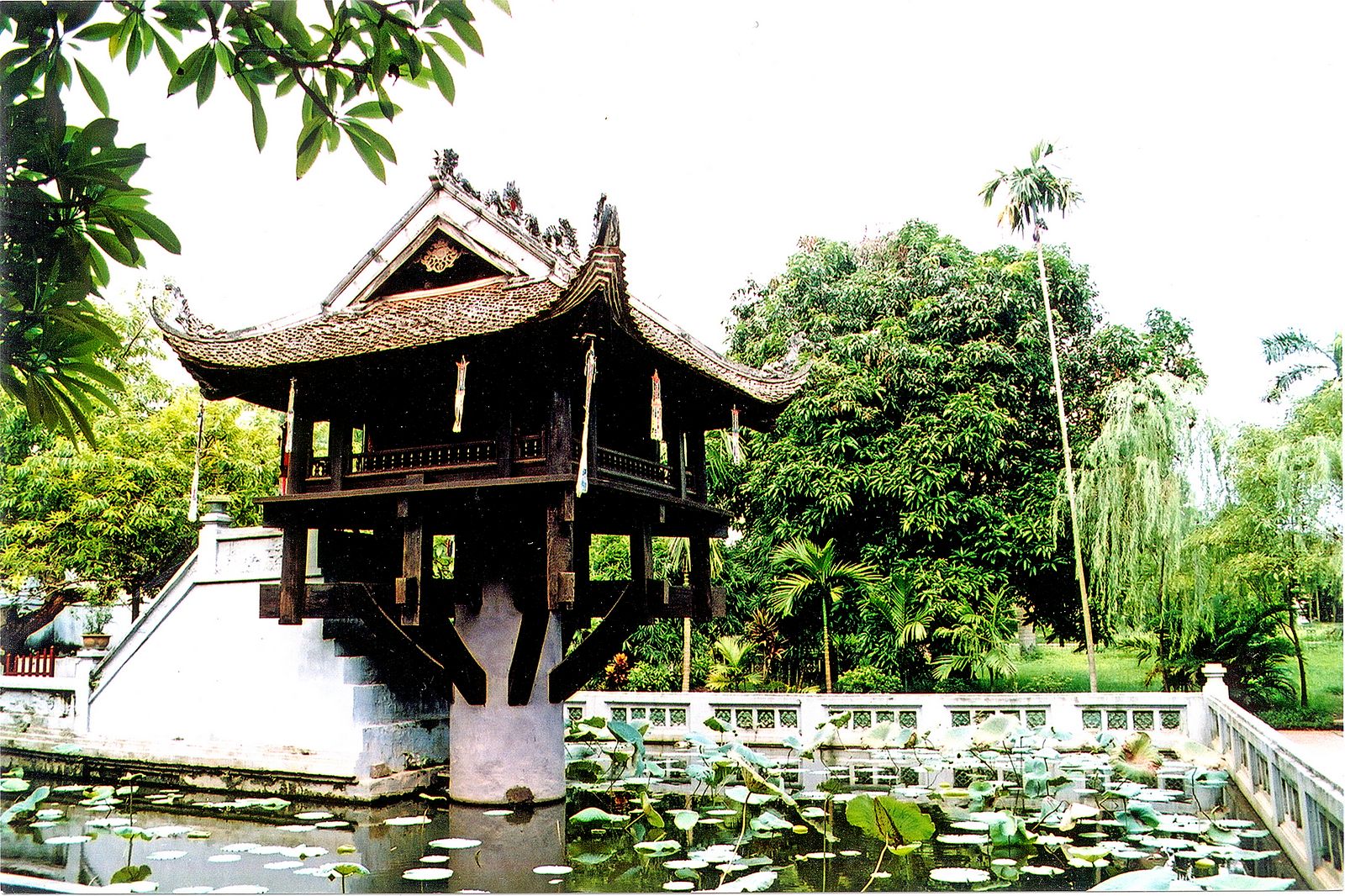Hanoi is the
capital of Vietnam. In 1010, with the Edict on transferring the capital ( Chieu
Doi Do ), Emperor Ly Thai To moved his capital from Hoa Lu to the confluence of
the Red River and the To Lich River, the site of Hanoi nowadays. The emperor
renamed the capital Thang Long, meaning the Ascending Dragon. Legend told us
that in the autumn of that year, when emperor Ly Thai To arrived by his royal
boat from the former capital of Hoa Lu in the shore of the Red River, Hanoi a
golden dragon approached his boat then flew hight into the sky. Believing this to
be a good omen, the emperor accordingly named the country’s capital after the
image of the ascending dragon. Under the Nguyen Dynasty, Thang Long was renamed
Hanoi.

The Hong Ha River winds around the city that accounts for the name of Hanoi ( literally Inside the River ). The river is so-called because its water, in the wet season, always filled with red alluvium, rapidly flows from its source and splashed into the sea. When this river swells, Hanoi is often flooded and needs to be protected by its dike system.
The most famous and impressive beauties of Hanoi are Hoan Kiem Lake and West Lake. Hoan Kiem Lake is a quiet and peaceful area in the busiest quarter of Hanoi. Since long, this lake area has provided a major outdoor recreational spot for the crowded population of the capital city. The name of Ho Hoan Kiem, the Restored Sword Lake, derived from the following popular legend. Five centuries ago, when still at Lam Son, the hero Le Loi asked the heavens for help in his armed revolt against the Ming invaders in 1418. The tortoise of Hoan Kiem Lake responded to his request with a magic sword that flashed lightning from its blade, which he used through his ten year resistance against the Northern invaders. With the Chinese vanquished, one day, boating on the Luc Thuy Lake ( as the Hoan Kiem Lake was formerly called ), the emperor saw the large tortoise rising from the lake. He pointed the sword at the tortoise but it in no time snatched the sword away and disappeared into the watery depths. In the heart of the lake is located the historic relic called Thap Rua ( the Tortoise Tower ), and not far from this tower stands the Ngoc Son Temple which was built on an islet and linked to the shore by a red wooden bridge called The Huc ( Sun Beams Bridge ).

The West
Lake is the largest lake in downtown Hanoi, covering an area of 500 hectares.
Located west of the city, this lake used to be the favorite recreational center
reserced for the emperors and their royal families for its natural beautiful
scenery. Many villages were early established around the lake specializing in
flower planting, silkworm raising and
paper making.
Most famouns in the West Lake area is the Tran Quoc Pagoda, which is built on
an islet. It is believed that this pagoda was built between 541-548AD firstly on
the banks of the Red River. When the banks eroded in 1615, the pagoda was moved
to its present site. It was renovated in 1991. This pagoda was originally a
temple named Khai Quoc ( Founding the Nation ) which was first built during the
reign of emperor Ly Nam De ( 544-548 . During the reign of Ly Nhan Tong, Queen
Y Lan often entertained this pagoda’s bonzes with vegetarian feasts. She also
frequented here to exchange her opinions about Buddhism with the bonzes.

The Chua Mot Cot ( One-Pillar Pagoda ) a miniature pagoda once alled the Temple of Love, was built in 1040 on a pillar constructed of a single large tree trunk in the center of Hanoi. A legend goes that one night in the year of 1049, Emperor Ly Thai To saw in his dream Kwan Yin ( The Goddess of Mercy ) leading him to a Lotus Shrine. Waking up, he consulted his officials, most of them were Buddhist monks, about his dream. The monk Thien Chieu advised the emperor to built a pagoda which resembled Buddha sitting on a lotus blossom growing out of the mud. The pagoda was renovated several times. The shape as we see now was rebuilt in 1955. It is a square structure, 3 meters each side, with curved-up roofs, resting on a single stone pillar.

In 1108, Queen Y Lan had a huge bell cast and named it ‘Giac The Chung’ ( The Bell that awakens the World ). This huge bell, however, was too heavy to be hung up and it didn’t sound when struck. It was consequently put lay waste in a deep rice paddy near the pagoda. In the 15th century, the Ming invated our country. Their commanding general Vuong Thong had the bell broken to get the bonze for making ammunition.
Hanoi, through numerous ups and downs in history, always remains the heart of the homeland. Hanoi has four distinct seasons with characteristic featured of each. In Spring, its weather is a little cold, charmed with soft drizzles and bright pink peach blossoms in full bloom. Its hot Summer is the hightime for Hanoians to have a good time strolling around Hoan Kiem lake. Hanoi’s autumn is fascinated with its blue sky and its poetic landscape, then the cold winter in turn comes at last.
Hanoians are remarkably refined and rather discreet. Their culinary art is excellent and wellknown. They are also famed for their traditional trades and arts. Hadong, in the south of Hanoi, is known for its quality silk and brocades, rattan and bamboo articles and wood products. Chuyen My village, on the bank of the Nhue River, carries on the centuries-old tradition of mother-of-pearl inlay. Bat Trang village in Gia Lam district has long been famous for its pottery which is rich in patterns and beautiful in forms, The ancient Hanoi’s 36 Streets and Wards bear the names of the businesses and trades that were once conducted here.
When you travel to Ha Noi, don't forget to order Y54U, pocket wifi VietNam, your travel companion. You can order online or at our shop at the Tan Son Nhat Airport in Hochiminh City. After clearing customs, pass through sliding doors, turn left & come to shop #3 to rent vietnam portable wifi.
